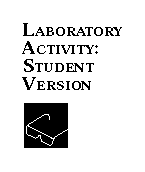

Activity 2: Identifying Products of a Reaction
Introduction
The ability to classify chemical reactions helps us to predict the products of the reaction. However, only experimentation can confirm the identity of substances produced in a chemical reaction. In this activity two solutions are mixed to initiate a chemical reaction. The identity of the products is confirmed by flame tests and another chemical reaction.
Purpose
To observe the reaction of calcium chloride and potassium carbonate, predict the products, and confirm the identity of the products.
Safety
- Wear eye protection throughout the laboratory activity.
- Hydrochloric acid is caustic and corrosive. If you spill any on your skin wash it off with water and notify the teacher. Skin contact with other chemicals and solutions should be avoided.
- Dispose of the chemical substances as your teacher directs.
Procedure
Before beginning the laboratory work, read through the entire procedure and prepare a data table. Record all data and observations in the table.
- Weigh 2.5 g potassium carbonate, K 2 CO 3 , and 2 g calcium chloride, CaCl 2 . Place in separate 100 mL beakers.
- Add 25 mL distilled water to each beaker. Stir until all the solid is dissolved.
- Number four 13 x 100-mm test-tubes from 1 to 4. Put 2 mL potassium carbonate solution in Tube 1 and 2 mL calcium chloride solution in Tube 2. Place a clean splint in Tubes 1 and 2.
- Fold a piece of filter paper to fit the funnel.
- Add the remaining solution of potassium carbonate to the remaining solution of calcium chloride. When the reaction is complete, filter the solution with pleated filter paper to hasten filtration. Remove the filtrate and wash the precipitate with 10 mL distilled water. If the filtrate is cloudy, filter again through the same filter paper.
- Place 2 mL filtrate and a clean splint in Tube 3.
- With a clean splint remove a small amount of precipitate from the filter paper. Put the splint and the solid in Tube 4. Add 2 mL distilled water.
- Perform flame tests by holding each wet splint from Tubes 1-4 in the burner flame. Observe the first color you see. Do not allow the splint to burn. Dispose of the splints in the trash can.
- Add three drops 3 M hydrochloric acid, HCl, to each solution in the test-tubes. Formation of bubbles indicates that the carbonate ion, CO 3 2- , was originally present.
- If your teacher directs, set aside some of the filtrate to observe the crystals that form.
- Dispose of the solutions and filter paper as your teacher directs.
- Thoroughly wash your hands before leaving the laboratory.
Data Analysis and Concept Development
- What evidence do you have that a chemical change has occurred?
- Describe the reactants and products.
- Using the results of the test performed on the solutions, identify the precipitate formed and the substance found in the filtrate.
Implications and Applications
- Draw pictures to represent:
a. CaCl 2 before the water is added.
b. CaCl 2 after the water is added.
c. K 2 CO 3 before the water is added.
d. K 2 CO 3 after the water is added.
e. The substance in the filter paper.
f. The substance dissolved in the filtrate.
- Lead(II) chromate, PbCrO 4 , can be used as a pigment to give a yellow color to paint. What compound could be added to Pb(NO 3 ) 2 to produce this pigment?
- The labels have come off two bottles of white solids in the chemistry storeroom. The labels are KCl and K 2 CO 3 . How could you determine which label belongs on which bottle?



